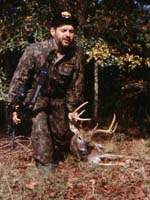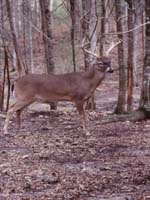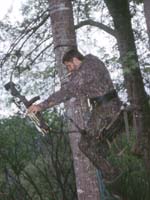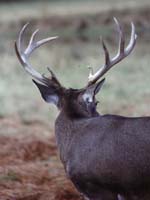
|
Features
|
|
|
|
Books
|
|
|
|
Fun & Games
|
|
|
|
Contact Us
|
|
|
John's Journal... Entry 96, Day 3
Greenfield Hunts
 EDITOR'S
NOTE: Often the lands containing the most deer sign won't produce
a buck. Any hunter who continues to hunt where he sees deer sign but no
deer may never take the deer making the sign.
EDITOR'S
NOTE: Often the lands containing the most deer sign won't produce
a buck. Any hunter who continues to hunt where he sees deer sign but no
deer may never take the deer making the sign.
You'll often find bagging a big buck with your gun or your bow over a greenfield a difficult task. You may see a nice-sized buck in a greenfield early in the morning or late in the afternoon before the season begins. But during hunting season, you very rarely will see the buck if the greenfield receives any hunting pressure at all. You may spot that buck only after dark, although you may find his tracks and bushes he's hooked around the edges of the field. To locate a tree stand site that will produce that buck the next deer season, you must begin your hunt this year as soon as deer season ends.
"Deer season ends the last day of January in Alabama where I mostly hunt," Larry Norton, a longtime deer hunter and guide, mentioned. "I scout at least two weeks after the season and particularly the day after a rain for a trophy buck I haven't been able to bag during the season but that has left plenty of sign that he's feeding in that greenfield at some time." Norton knows that after a rain, deer will feed in greenfields and get their feet muddy. When they leave a greenfield, they'll carry the mud on their feet and make a well-defined trail from the greenfield to their bedding area. Norton follows the trail of mud until he pinpoints the spot where the trail of mud intersects with a second or a third trail and runs into thick cover where he believes the deer will bed.
 "I
keep extensive notes on deer movement, because I'll need this information
eight or nine months later when deer season begins," Norton explained.
"I'll never remember exactly where the trail goes without keeping meticulous
notes, since I hunt many different lands for several days each season.
But the beginning of the next hunting season when leaves cover the ground
and the bushes still are green, I can use my logbook to return to that
trail. Otherwise I may not have been able to spot the trail because of
the ground cover and foliage. Then I set up a tree stand -- either near
the area where I've found the trails crossing after the season or close
to the bedding site." Norton knows older age-class bucks will come down
a trail and wait in the woods away from the greenfields until dark before
going into the greenfield to feed. By having studied deer's movement patterns
after the season, Norton usually can bag a buck going to a greenfield
early in the following season either at a trail crossing or close to its
bedding area.
"I
keep extensive notes on deer movement, because I'll need this information
eight or nine months later when deer season begins," Norton explained.
"I'll never remember exactly where the trail goes without keeping meticulous
notes, since I hunt many different lands for several days each season.
But the beginning of the next hunting season when leaves cover the ground
and the bushes still are green, I can use my logbook to return to that
trail. Otherwise I may not have been able to spot the trail because of
the ground cover and foliage. Then I set up a tree stand -- either near
the area where I've found the trails crossing after the season or close
to the bedding site." Norton knows older age-class bucks will come down
a trail and wait in the woods away from the greenfields until dark before
going into the greenfield to feed. By having studied deer's movement patterns
after the season, Norton usually can bag a buck going to a greenfield
early in the following season either at a trail crossing or close to its
bedding area.
With the advent of GPS, a more precise way to keep up with deer trails has evolved. You can walk the trail and mark and log it in your GPS receiver. Then the next year when you go to the same greenfield, you easily can pull up the trail's name or number. You can use your GPS receiver to guide you back to the spot or places where you've predetermined you need to put a tree stand. The GPS receiver doesn't eliminate the need for keeping a hunter's daily log of deer sightings, weather conditions and deer sign seen. However, it will allow you to follow an invisible deer trail back to a tree stand site a year or five years later, once you log the trail into your receiver.
 To
scout for deer quickly and easily, ride up and down roads, and search
for deer and deer trails. If you see a buck cross the road, you know the
deer has come from one location to move to another place and will leave
some type of deer trail. Begin your scouting at the edge of that road,
and follow the trail into the woods on both sides of the road. "Remember
too that not all deer cross roads," Norton advised. "I've found some of
the best places to scout bucks are close to roads under bridges. Since
older age-class bucks like to remain out of sight, many times they'll
go back and forth from one woodlot to another under bridges by walking
the edges of creeks. Then those deer never have to cross a road and expose
themselves to that open terrain."
To
scout for deer quickly and easily, ride up and down roads, and search
for deer and deer trails. If you see a buck cross the road, you know the
deer has come from one location to move to another place and will leave
some type of deer trail. Begin your scouting at the edge of that road,
and follow the trail into the woods on both sides of the road. "Remember
too that not all deer cross roads," Norton advised. "I've found some of
the best places to scout bucks are close to roads under bridges. Since
older age-class bucks like to remain out of sight, many times they'll
go back and forth from one woodlot to another under bridges by walking
the edges of creeks. Then those deer never have to cross a road and expose
themselves to that open terrain."
 If
you locate good buck sign like big deer tracks, large trees and bushes
with scrapes and rubs and deer droppings in or near thick cover close
to the road but can't pinpoint the trail the deer utilize to get to the
area, look under the nearest bridge. You may find a deer trail and the
route of travel the buck takes. By following the trail back to the buck's
bedding area and setting up a tree stand near there, you often can see
and bag the buck you'll never spot around deer sign you've found close
to the road.
If
you locate good buck sign like big deer tracks, large trees and bushes
with scrapes and rubs and deer droppings in or near thick cover close
to the road but can't pinpoint the trail the deer utilize to get to the
area, look under the nearest bridge. You may find a deer trail and the
route of travel the buck takes. By following the trail back to the buck's
bedding area and setting up a tree stand near there, you often can see
and bag the buck you'll never spot around deer sign you've found close
to the road.
TOMORROW: Deer-Movement Patterns
Check back each day this week for more about Lying Sign ...
Day 1 -Deer Sign that Lies
Day 2 -Thick-Cover Hunts
Day 3 -Greenfield Hunts
Day 4 -Deer-Movement Patterns
Day 5 -Alternative Food Source